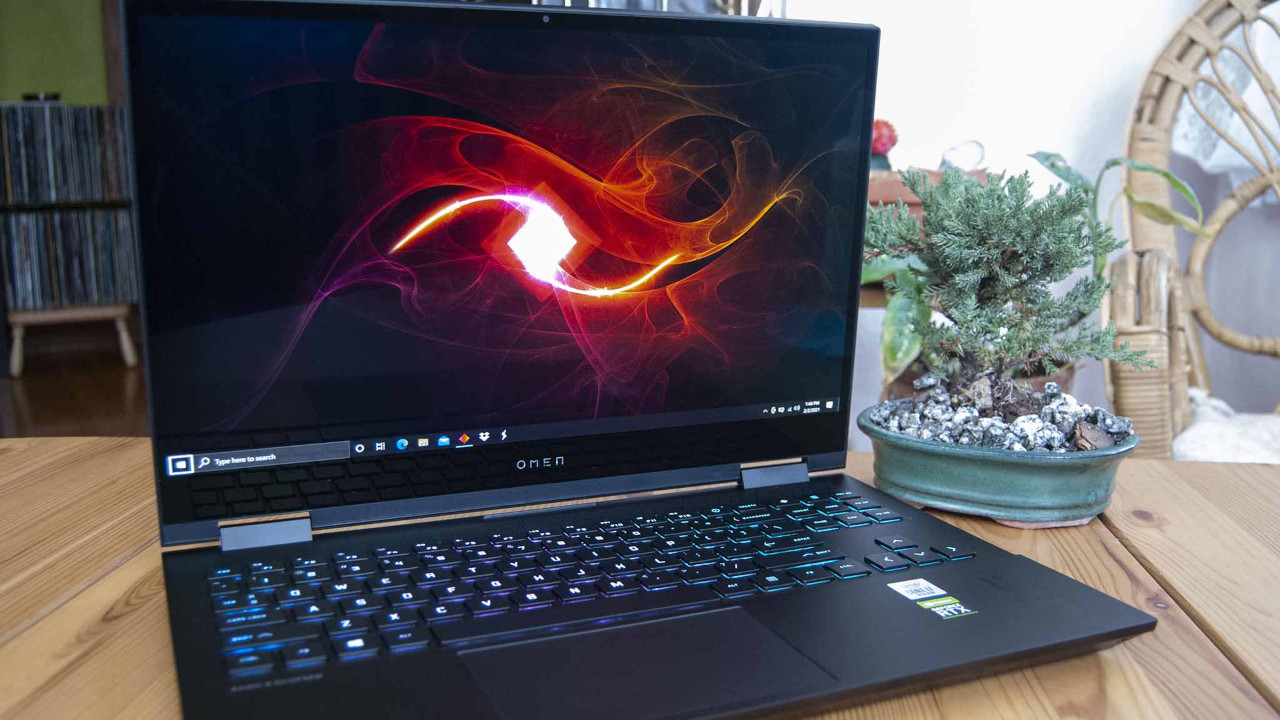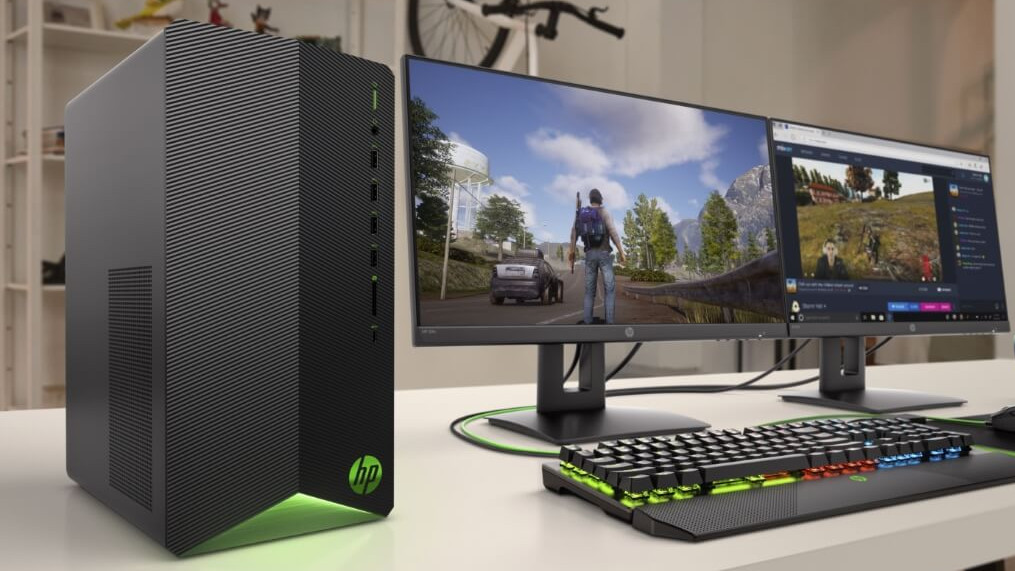Simulation racers are reaching a broader audience thanks to a healthy variety of racing wheels available for consoles and PC, welcoming newcomers to the genre and allowing enthusiasts to expand their hobby to multiple platforms. If you’re looking to start from scratch, a pre-built computer is an ideal way to skip the task of matching compatible components. We’ve found the best PC for sim racing and some alternatives to match your budget.
Best PCs for sim racing

The HP Omen 45L (opens in new tab) is larger than its predecessor, but that’s mostly down to an innovative new “Cryo Chamber” cooling solution. In an era where building your PC is so common, many manufacturers try to think outside the box with their desktop rigs, and HP certainly did that. The chamber is separated from other components so that internal temperatures can be up to 6 degrees lower, thanks to the lack of heated air inside the machine.
On the one hand, you might say the design is a little uninspiring, but to the PC gamer, this is a machine where function is the primary concern, and ease of access is paramount. Pull the glass side panel off, and you have free access to all internal components, all of which can be upgraded over time. It supports a full ATX motherboard, though out of the box HP used a microATX, which limits both built-in functions a little and how much you can expand.
The Omen 45L boasts the latest high-end NVIDIA RTX GPU lineup with the RTX 3090 as the top-end solution or AMD Radeon graphics, CPUs from Intel’s 12th Gen desktop lineup, or AMD’s Ryzen 5000 Series, DDR4 RAM from HyperX, SSD storage — it ticks all the boxes.
Absolutely everything is replaceable, including the radiator in the Cryo Chamber, and the bottom line is that this is a PC any enthusiast would be happy to use. HP did the hard work for you, though.

Dell’s Alienware Aurora is a fantastic PC for sim racing. Whether you want to run in VR, on a single monitor, a massive ultrawide, or triples, the Aurora can be kitted out to deliver high-quality graphics and high frame rates. What also helps set it apart is that it’s fairly compact, considering how much is inside.
There are quite a few configuration options available for the Aurora, with a high-end model sporting the beefy RTX 3090, an 11th or 12th Gen Intel processor (CPU), 128GB of HyperX DDR4-3200MHz RAM, and a 2TB M.2 PCIe solid-state drive (SSD) coupled with a 2TB hard-disk drive (HDD). You can add a Wi-Fi 6 (opens in new tab) adapter for blazing wireless speeds, and you can even add water cooling with an 850W PSU. Equally, the entry-level model is still capable of sim racing on a tighter budget, with even the GTX 1650 perfectly serviceable in titles like iRacing.
The hardware is all contained in a sleek and compact case available in two colors. It still has a PSU swing arm, allowing easy access for tool-free upgrades and tinkering. There’s a boatload of ports for easy connectivity, mainly for sim racing when you’ve got multiple devices that all want a USB connection to your PC.

An offshoot of gaming PC manufacturer Digital Storm, the Redux gaming PC (opens in new tab) offers a pre-built machine at a more affordable price with impressive specs. Available in three variations, the entry-level Redux tower includes an Intel 12th Gen Core i5 CPU and NVIDIA GeForce RTX 3050 GPU, easily handling most racing games with decent settings. There’s no mouse and keyboard included with Redux PCs, but that’s likely not much of a concern if you’re looking to build a rig for a racing sim. You could attach a couple of bargain peripherals to navigate the operating system and get straight to the games.
Jump up to something more expensive, and you can have the ridiculously powerful GeForce RTX 3090Ti with 32GB of DDR4 RAM. Something to consider if you’re planning to set up a giant screen for your simulation setup to race in 4K. Radeon graphics aren’t supported in these custom builds, so it’s NVIDIA or bust, but the tool-less case design makes it easy to swap out any components you see fit. Cable management is a breeze, too, even with a case destined for the budget end of the spectrum. If you do decide to change anything Redux has installed, rest assured you’ll be able to get everything just as tidy as when it arrived.
They’re out to take on the competition in the likes of Alienware, with more of a transparent pricing model. Some components creep over their MSRP, but it’s still a fantastic way to bypass the semiconductor shortage and grab a high-end gaming PC without the stress of sourcing parts yourself. Pair a Redux tower with a set of pedals and a wheel, and you’ll be off to the races in no time.

HP offers the Omen 15 as a laptop variant of its desktop range as a portable option for simulation racing or something more compact to attach to a cockpit rig with pedals and a wheel. Up to a 10th Gen Intel Core i7 or Ryzen 7 CPU can be paired with a mobile version of the NVIDIA GeForce RTX 3070 graphics chip. 16GB of DDR SDRAM clocked at 2,933MHz will handle most racing games just fine, even with plenty of cars on screen, AI-controlled or otherwise.
You can choose up to a 1TB M.2 solid-state drive, which might be a little overkill if you’re planning to use this laptop solely for racing games, but the extra space is handy should you consider user-made modifications to add extra tracks and cars, etc. Onboard Wi-Fi 6 tech supports high-speed wireless networking, which is ideal if you want to keep your setup as cable-free as possible and still play online.
Display options include up to a 15.6-inch QHD display at a 300Hz refresh rate and 300 nits brightness. The display is arguably less important if you’re looking at powering a sim racing rig, but it’s still good to have a quality panel. You also get all the connectivity you need with multiple ports, including USB, HDMI, and Thunderbolt, for attaching all your racing hardware.

An entry-level machine can be capable enough for an absolute beginner to get you up and running (or driving) with simulation racing. This HP Pavilion is about as low as you want for a starter computer. Easy to upgrade, this tower comes with the capable NVIDIA GeForce GTX 1650 graphics card that’ll sit you somewhere between the minimum and recommended specs for iRacing. You can upgrade any component you like since it uses all standard parts, but this plucky GPU is a great starting place.
The 10th Gen Intel Core i3 CPU and 8GB of DDR4 RAM will handle basic simulation racing, but if you’re planning to join giant races with more players, you will need to upgrade. 256GB of storage will be acceptable if you stick to a handful of games, but venturing into games like Forza Horizon 5 (opens in new tab) will require much more since they take up a hefty amount of space. HP generously includes a mouse and keyboard with the Pavilion gaming desktop, so the setup is ready to go straight out of the box.
It won’t provide you with a hyper-realistic 4K gaming experience, but the HP Pavilion gaming desktop is a decent way to enter PC gaming. You’ll either have to stick with low-to-mid graphics settings or play more basic titles at first, but upgrades are easy enough with a bit of research. It’s a decent way to test the waters of sim racing on PC if you’re unsure.
Choosing the best PC for sim racing
Getting started in sim racing is pretty straightforward, and though you can’t engage without a decent PC and racing setup, it’s easy enough to get going. You need a solid PC at the heart of your setup, and the HP Omen 45L is a perfect choice. It doesn’t take up masses of space; it’s easily upgradeable if your budget doesn’t stretch to the higher-spec models right now, and it’s got plenty of ports to connect all your assorted racing hardware, including the best racing wheels (opens in new tab). You really can’t go wrong.
Suppose you’re approaching the scene as an absolute beginner and have never owned a PC. In that case, the HP Pavilion gaming desktop is a great way to get started without dropping specs to the point that racing games are unplayable. All of the PCs here are capable of handling all the virtual racing you can throw at them with multiple monitors or even VR for high-spec models.




